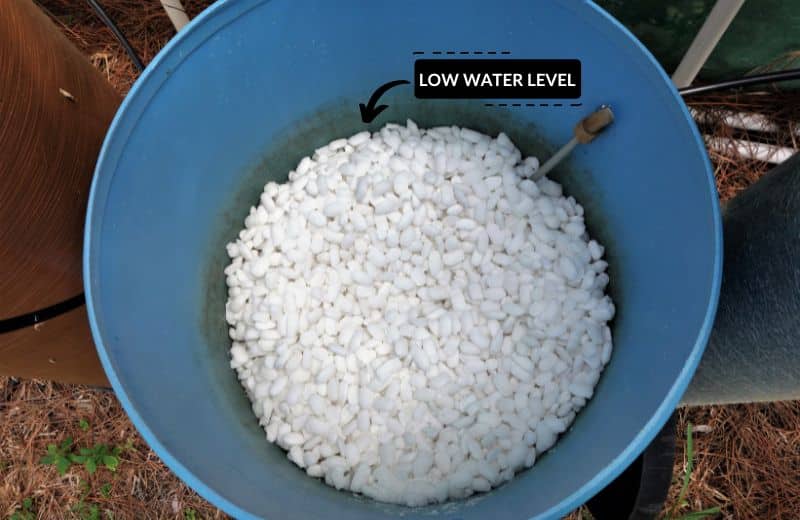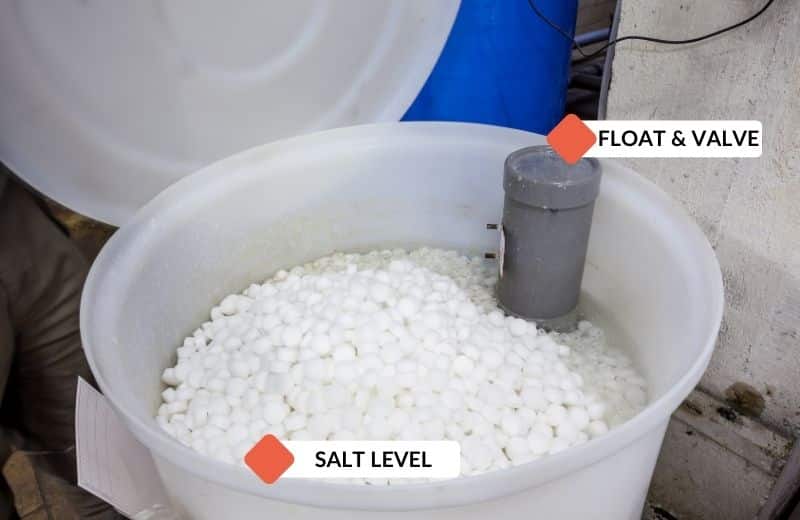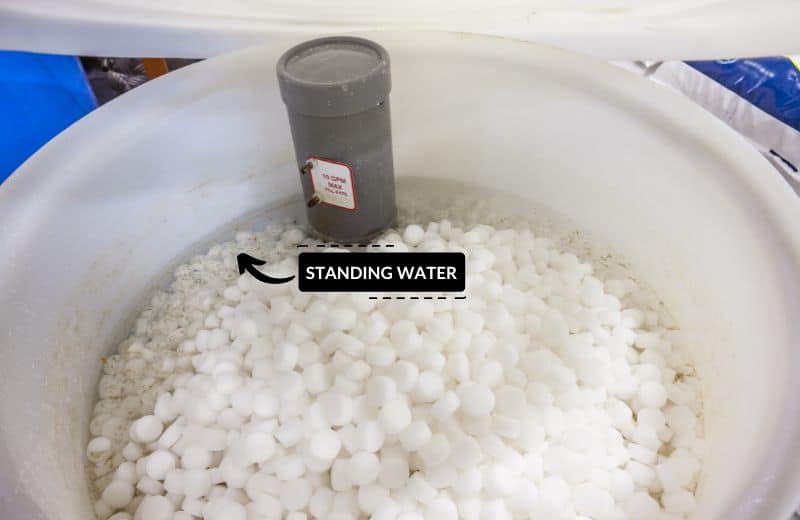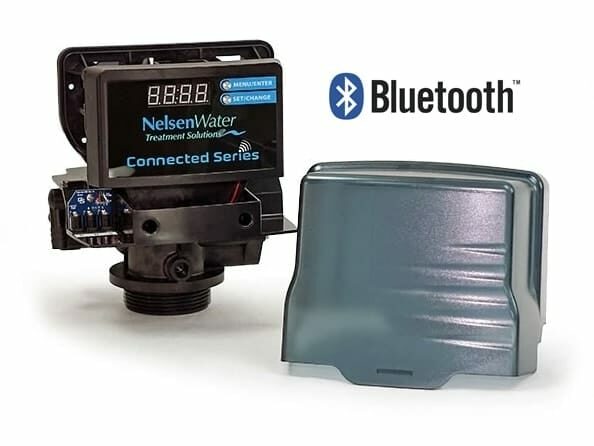Owning a water softener is a big responsibility. These systems are capable of eliminating limescale issues in your home – but only when you look after them.
On the face of it, water softener maintenance is simple. You just add a bag of salt to the brine tank every 2 to 3 months and clean the system as recommended by the manufacturer.
Sounds easy enough, doesn’t it?
Very. But the real challenge is when a problem arises that you’re not sure how to fix. Sometimes, you might not even know that a problem is there, because you don’t know what to look for.
The brine tank is one of the most essential parts of a water softener – and it’s also the most likely to face problems. It’s important to know what it looks like on a good day, so you can quickly diagnose an issue if the system isn’t functioning properly.
In this post, I’ll help you to get to grips with how much water should be in your brine tank, depending on the type of unit you own.
Table of Contents
🤔 So, How Much Water Should Be in My Water Softener Brine Tank, Anyway?
To start, if you’ve noticed water in your brine tank, that’s a good thing! Brine tanks require water to operate.
The tank’s salt dissolves in the water to form a solution called brine. This brine then travels into the resin tank during your water softener’s regeneration cycle, cleaning the resin with the right amount of salt it requires for ion exchange. Without water, the salt would be unable to travel into the brine tank, and softening couldn’t take place.
However, striking the balance just right is important. Too much or too little water could be just as performance-hampering as no water at all.
You’ll benefit from understanding how your water softener works before you read on any further. I’ve shared a free, handy infographic covering the water softening process if you want to better understand these systems.
The “normal” amount of water in your brine tank depends on what type of brine tank or equipment you own.

Wet Brine Tank
A wet brine tank is typically found on an older water softener system (purchased prior to abut 2015). This type of tank should hold water 24/7, and the size of the tank will determine the exact amount of water it stores. Typically, a wet brine tank will hold between 3 and 6 gallons of water, with a water level from around 6 to 19 inches in height.
There are many reasons why your wet brine tank might contain less water than it needs. Your drain may be blocked, or even frozen, if you’ve installed your system outside. The tank could also have a mechanical issue – or there may be nothing wrong at all! When the tank is filled with salt, it’s pretty normal to be unable to see the top of the water level.
The clearest indication that you’re facing a problem is if your salt levels are low and you still can’t see much (or any) water.
Dry Brine Tank
A dry brine tank is easily identifiable by its digital valve, which helps to regulate the system. If you more recently purchased a newer water softener, it’s likely that it’ll have a dry brine tank.
A dry brine tank isn’t always dry. As I mentioned earlier in this post, a water softener brine tank needs water to properly perform. But the tank will empty of water once the system’s regeneration cycle has been carried out. It will then fill with water before the ion exchange process.
If you’re not sure whether your water softener has a wet or dry salt tank, contact the company you bought the softener from or consult the user manual.

💦 Should There Be Standing Water in My Water Softener?
Water in your water softener brine tank is very normal, but, depending on the type of system you own, it may be a sign that something is wrong.
There are several reasons why your water softener brine tank contains standing water. Remember, this could simply be because water is needed for the regeneration or ion exchange process. But if there’s too much water, water isn’t emptying from your brine tank, and/or your water tastes like hardness minerals, you may have a problem with the system.
Your water softener brine tank will usually be about half-full of water. Excess standing water in the brine tank can be caused by:
- Problems with the incoming brine line
- Malfunction of the brine tank drain line
- Clogged salt inside the tank
- Issues with the drain line and brine line flow control
- System malfunction
- Safety float valve issues
- Blocked injector
I’ve covered these points in more detail in my this post about how to fix standing water in a brine tank.
It’s wise to diagnose and resolve any issues with your softener as quickly as possible if you want to benefit from calcium, magnesium and iron-free water going forward.
Issues with the system’s tanks can also affect its performance and even its lifespan. If you see water where it shouldn’t be, you don’t think the right amount of water is in your unit, or there’s no water at all, I recommend that you contact a company that can help you get to the bottom of the issue.

💭 Considerations When Assessing Water Level in the Brine Tank
How much water in the brine tank of your unit depends on several factors. No two water softeners are the same, which can make it difficult to understand whether your water level is normal or not.
Typically, your water level should always be a couple of inches lower than your salt level. This can make it even more of a challenge to have an accurate understanding of the amount of water in your softener. However, one thing is for certain – the salt tank should never be full of water.
When determining how much water your water softener needs, consider the following things:
Type of Softener
Pre-fill water softeners, or those with dry brine tanks, contain almost no water until the regeneration cycle begins. This means that it’s normal, if you own one of these water softeners, to see very little water in the brine tank.
How much water these water softeners need for regeneration depends on the amount of salt the brine tank can hold. But you don’t need to worry about how many inches high your water level is unless you can never see any water – even when the system is supposed to regenerate.
If you own a water softener with a wet brine tank, the tank should be at least one-quarter full at all times. You might not always see the water, especially if you’ve just topped up the tank with salt. I recommend carrying out a water test to check for hardness minerals if you’re not sure whether proper regeneration is taking place.
System Efficiency
The efficiency of your water softener may also affect how much water it requires. The more efficient water softeners don’t require much salt to regenerate. The less salt required, the less water the unit will need to use.
The brine tanks in the more efficient water softeners tend to be a lot smaller, but the salt-to-water ratio will still be virtually the same as in a less efficient softener with a larger tank.
Softener Settings
The majority of water softeners allow you to program your own settings for regeneration. Your water softener should let you choose how much salt is used per regeneration.
You don’t have to take control of your water treatment, though – all modern systems are smart enough to auto-program settings based on your water usage, tank capacity or hardness levels.
Having the correct settings can ensure you have constant access to scale-free water without wasting water and salt in the regeneration process. If you don’t have a smart unit, you can test your water for calcium, magnesium, manganese and iron, then input the results into your control head.
Your water softener will do the rest of the work, determining how much water and salt is needed for your soft water treatment.
A single gallon of water can absorb around 3 lbs of salt. Let’s say, then, that your water softener uses 6 lbs of salt in a regeneration cycle. In this case, your water softener would estimate that you need 2 gallons of water to make the brine solution.

👨🔧 Professional Advice For A Brine Tank Full of Water
To properly maintain a water softener, the general rule of thumb is to add enough salt to keep your brine tank at least one-quarter full at all times. You should never fill the salt past 4-6 inches below the very top of the tank.
If you’re dealing with a water issue, it may help to empty the tank, flush the softener out, pour in a new batch of salt and start again. Cleaning the brine tank will usually also prove helpful.
If the amount of water in your brine tank is way too high, and you can’t diagnose the problem yourself, you will need to seek help from an expert.
A plumber or handyman may be able to help you diagnose the issue over the phone (this won’t likely be free!).
For bigger issues, you can arrange for a professional to visit your home and fix the issue for you.
If your water softener is old and lacking in quality/ no longer usable, your plumber may advise that you replace a malfunctioning component or purchase a new system.
